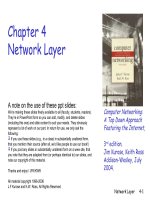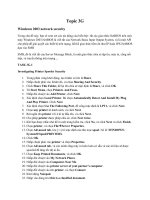routing algorithms (comouter network topdow)
Bạn đang xem bản rút gọn của tài liệu. Xem và tải ngay bản đầy đủ của tài liệu tại đây (298.39 KB, 44 trang )
Routing Algorithms and Routing
in the Internet
Network Layer 4-1
Interplay between routing and
forwarding
routing algorithm
local forwarding table
header
output link
value0100 3
0101
0111
1001
2
2
1
value in arriving
packet’s header
0111
1
3 2
Network Layer 4-2
Graph abstraction
5
2
u
2
1
Graph: G = (N,E)
v
x
3
w
3
1
5
z
1
y
2
N = set of routers = { u, v, w, x, y, z }
E = set of links ={ (u,v), (u,x), (v,x), (v,w), (x,w), (x,y), (w,y), (w,z), (y,z) }
Remark: Graph abstraction is useful in other network contexts
Example: P2P, where N is set of peers and E is set of TCP connections
Network Layer 4-3
Graph abstraction: costs
5
2
u
v
2
1
x
• c(x,x’) = cost of link (x,x’)
3
w
3
1
5
z
1
y
- e.g., c(w,z) = 5
2
• cost could always be 1, or
inversely related to bandwidth,
or inversely related to
congestion
Cost of path (x1, x2, x3,…, xp) = c(x1,x2) + c(x2,x3) + … + c(xp-1,xp)
Question: What’s the least-cost path between u and z ?
Routing algorithm: algorithm that finds least-cost path
Network Layer 4-4
Routing Algorithm classification
Global or decentralized
information?
Global:
❒ all routers have complete
topology, link cost info
❒ “link state” algorithms
Decentralized:
❒ router knows physicallyconnected neighbors, link
costs to neighbors
❒ iterative process of
computation, exchange of info
with neighbors
❒ “distance vector” algorithms
Static or dynamic?
Static:
❒ routes change slowly
over time
Dynamic:
❒ routes change more
quickly
❍ periodic update
❍ in response to link
cost changes
Network Layer 4-5
A Link-State Routing Algorithm
Dijkstra’s algorithm
net topology, link costs
known to all nodes
❍ accomplished via “link
state broadcast”
❍ all nodes have same info
❒ computes least cost paths
from one node (‘source”) to
all other nodes
❍ gives forwarding table
for that node
❒ iterative: after k iterations,
know least cost path to k
dest.’s
❒
Notation:
❒ c(x,y): link cost from node
x to y; = ∞ if not direct
neighbors
❒ D(v): current value of cost
of path from source to
dest. v
❒ p(v): predecessor node
along path from source to v
❒ N': set of nodes whose
least cost path definitively
known
Network Layer 4-6
Dijsktra’s Algorithm
1 Initialization:
2 N' = {u}
3 for all nodes v
4
if v adjacent to u
5
then D(v) = c(u,v)
6
else D(v) = ∞
7
8 Loop
9 find w not in N' such that D(w) is a minimum
10 add w to N'
11 update D(v) for all v adjacent to w and not in N' :
12
D(v) = min( D(v), D(w) + c(w,v) )
13 /* new cost to v is either old cost to v or known
14 shortest path cost to w plus cost from w to v */
15 until all nodes in N'
Network Layer 4-7
Dijkstra’s algorithm: example
Step
0
1
2
3
4
5
N'
u
ux
uxy
uxyv
uxyvw
uxyvwz
D(v),p(v) D(w),p(w)
2,u
5,u
2,u
4,x
2,u
3,y
3,y
D(x),p(x)
1,u
D(y),p(y)
∞
2,x
D(z),p(z)
∞
∞
4,y
4,y
4,y
5
2
u
v
2
1
x
3
w
3
1
5
z
1
y
2
Network Layer 4-8
Dijkstra’s algorithm, discussion
Algorithm complexity: n nodes
❒ each iteration: need to check all nodes, w, not in N
❒ n(n+1)/2 comparisons: O(n2)
❒ more efficient implementations possible: O(nlogn)
Oscillations possible:
❒ e.g., link cost = amount of carried traffic
D
1
1
0
A
0 0
C
e
1+e
e
initially
B
1
2+e
A
0
D 1+e 1 B
0
0
C
… recompute
routing
0
D
1
A
0 0
C
2+e
B
1+e
… recompute
2+e
A
0
D 1+e 1 B
e
0
C
… recompute
Network Layer 4-9
Distance Vector Algorithm (1)
Bellman-Ford Equation (dynamic programming)
Define
dx(y) := cost of least-cost path from x to y
Then
dx(y) = min {c(x,v) + dv(y) }
where min is taken over all neighbors of x
Network Layer 4-
Bellman-Ford example (2)
5
2
u
v
2
3
w
3
Clearly, dv(z) = 5, dx(z) = 3, dw(z) = 3
5
z
1
B-F equation says:
du(z) = min { c(u,v) + dv(z),
y
1
c(u,x) + dx(z),
c(u,w) + dw(z) }
= min {2 + 5,
1 + 3,
5 + 3} = 4
Node that achieves minimum is next
hop in shortest path ➜ forwarding table
1
x
2
Network Layer 4-
Distance Vector Algorithm (3)
❒
Dx(y) = estimate of least cost from x to y
❒
Distance vector: Dx = [Dx(y): y є N ]
❒
Node x knows cost to each neighbor v: c(x,v)
❒
Node x maintains Dx = [Dx(y): y є N ]
❒
Node x also maintains its neighbors’ distance vectors
❍
For each neighbor v, x maintains
Dv = [Dv(y): y є N ]
Network Layer 4-
Distance vector algorithm (4)
Basic idea:
❒ Each node periodically sends its own distance
vector estimate to neighbors
❒ When node a node x receives new DV estimate
from neighbor, it updates its own DV using B-F
equation:
Dx(y) ← minv {c(x,v) + Dv (y)}
for each node y ∊ N
❒ Under minor, natural conditions, the estimate Dx (y)
converge the actual least cost dx(y)
Network Layer 4-
Distance Vector Algorithm (5)
Iterative, asynchronous:
each local iteration caused
by:
❒ local link cost change
❒ DV update message from
neighbor
Distributed:
❒
each node notifies
neighbors only when its DV
changes
❍
neighbors then notify
their neighbors if
necessary
Each node:
wait for (change in local link
cost of msg from neighbor)
recompute estimates
if DV to any dest has
changed, notify neighbors
Network Layer 4-
Dx(z) = min{c(x,y) +
Dy(z), c(x,z) + Dz(z)}
= min{2+1 , 7+0} = 3
Dx(y) = min{c(x,y) + Dy(y), c(x,z) + Dz(y)}
= min{2+0 , 7+1} = 2
node x table
cost to
x y z
x ∞∞ ∞
y ∞∞ ∞
z 71 0
from
from
from
from
x 0 2 7
y 2 0 1
z 7 1 0
cost to
x y z
x 0 2 7
y 2 0 1
z 3 1 0
x 0 2 3
y 2 0 1
z 3 1 0
cost to
x y z
x 0 2 3
y 2 0 1
z 3 1 0
x
2
y
7
1
z
cost to
x y z
from
from
from
x ∞ ∞ ∞
y 2 0 1
z ∞∞ ∞
node z table
cost to
x y z
x 0 2 3
y 2 0 1
z 7 1 0
cost to
x y z
cost to
x y z
from
from
x 0 2 7
y ∞∞ ∞
z ∞∞ ∞
node y table
cost to
x y z
cost to
x y z
x 0 2 3
y 2 0 1
z 3 1 0
time
Network Layer 4-
Distance Vector: link cost changes
Link cost changes:
❒ node detects local link cost change
❒ updates routing info, recalculates
distance vector
❒ if DV changes, notify neighbors
“good
news
travels
fast”
1
x
4
y
50
1
z
At time t0, y detects the link-cost change, updates its DV,
and informs its neighbors.
At time t1, z receives the update from y and updates its table.
It computes a new least cost to x and sends its neighbors its DV.
At time t2, y receives z’s update and updates its distance table.
y’s least costs do not change and hence y does not send any
message to z.
Network Layer 4-
Distance Vector: link cost changes
Link cost changes:
❒ good news travels fast
❒ bad news travels slow - “count to infinity” problem!
❒ 44 iterations before algorithm stabilizes: see text
60
Poissoned reverse:
❒ If Z routes through Y to get to X :
❍
Z tells Y its (Z’s) distance to X is infinite (so Y won’t route to X via Z)
❒ will this completely solve count to infinity problem?
x
4
y
50
1
z
Network Layer 4-
Comparison of LS and DV algorithms
Message complexity
LS: with n nodes, E links, O(nE)
msgs sent
❒ DV: exchange between
neighbors only
❍ convergence time varies
❒
Speed of Convergence
LS: O(n2) algorithm requires
O(nE) msgs
❍ may have oscillations
❒ DV: convergence time varies
❍ may be routing loops
❍ count-to-infinity problem
❒
Robustness: what happens if
router malfunctions?
LS:
❍
❍
DV:
❍
❍
node can advertise incorrect
link cost
each node computes only its
own table
DV node can advertise
incorrect path cost
each node’s table used by
others
• error propagate thru
network
Network Layer 4-
Hierarchical Routing
Our routing study thus far - idealization
❒ all routers identical
❒ network “flat”
… not true in practice
scale: with 200 million
destinations:
can’t store all dest’s in
routing tables!
❒ routing table exchange
would swamp links!
❒
administrative autonomy
internet = network of
networks
❒ each network admin may
want to control routing in its
own network
❒
Network Layer 4-
Hierarchical Routing
aggregate routers into
regions, “autonomous
systems” (AS)
❒ routers in same AS run
same routing protocol
❒
❍
❍
Gateway router
❒ Direct link to router in
another AS
“intra-AS” routing
protocol
routers in different AS
can run different intraAS routing protocol
Network Layer 4-
Interconnected ASes
3c
3a
3b
AS3
1a
2a
1c
1d
1b
Intra-AS
Routing
algorithm
2c
AS2
AS1
Inter-AS
Routing
algorithm
Forwarding
table
❒
2b
Forwarding table is
configured by both
intra- and inter-AS
routing algorithm
❍
❍
Intra-AS sets entries
for internal dests
Inter-AS & Intra-As
sets entries for
external dests
Network Layer 4-
Inter-AS tasks
❒
AS1 needs:
1. to learn which dests
are reachable through
AS2 and which
through AS3
2. to propagate this
reachability info to all
routers in AS1
Job of inter-AS routing!
Suppose router in AS1
receives datagram for
which dest is outside
of AS1
❍
Router should forward
packet towards on of
the gateway routers,
but which one?
3c
3a
3b
AS3
1a
2a
1c
1d
1b
2c
AS2
2b
AS1
Network Layer 4-
Example: Setting forwarding table
in router 1d
❒
Suppose AS1 learns from the inter-AS protocol that subnet x is
reachable from AS3 (gateway 1c) but not from AS2.
❒
Inter-AS protocol propagates reachability info to all internal
routers.
❒
Router 1d determines from intra-AS routing info that its interface
I is on the least cost path to 1c.
❒
Puts in forwarding table entry (x,I).
Network Layer 4-
Example: Choosing among multiple ASes
Now suppose AS1 learns from the inter-AS protocol
that subnet x is reachable from AS3 and from AS2.
❒ To configure forwarding table, router 1d must
determine towards which gateway it should forward
packets for dest x.
❒ This is also the job on inter-AS routing protocol!
❒ Hot potato routing: send packet towards closest of
two routers.
❒
Learn from inter-AS
protocol that subnet
x is reachable via
multiple gateways
Use routing info
from intra-AS
protocol to
determine
costs of least-cost
paths to each
of the gateways
Hot potato routing:
Choose the
gateway
that has the
smallest least cost
Determine from
forwarding table the
interface I that leads
to least-cost gateway.
Enter (x,I) in
forwarding table
Network Layer 4-
Intra-AS Routing
Also known as Interior Gateway Protocols (IGP)
❒ Most common Intra-AS routing protocols:
❒
❍
RIP: Routing Information Protocol
❍
OSPF: Open Shortest Path First
❍
IGRP: Interior Gateway Routing Protocol (Cisco
proprietary)
Network Layer 4-









